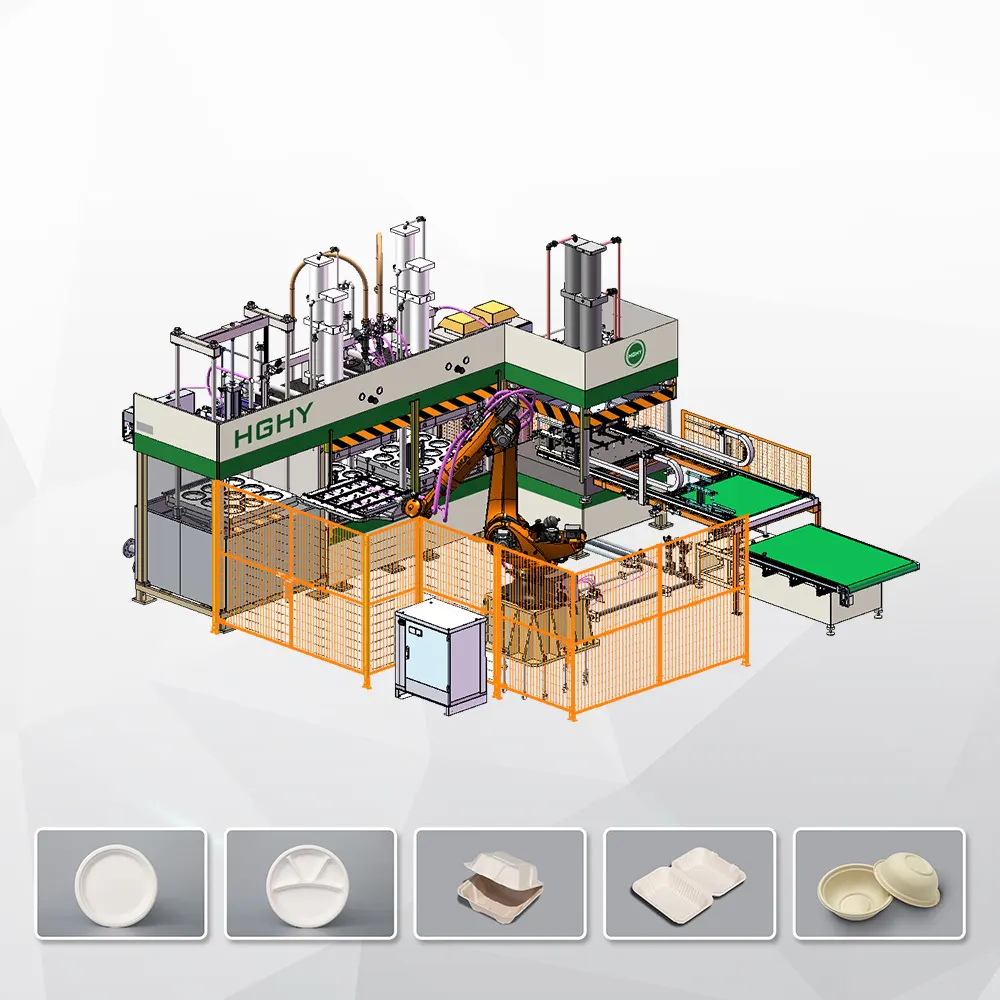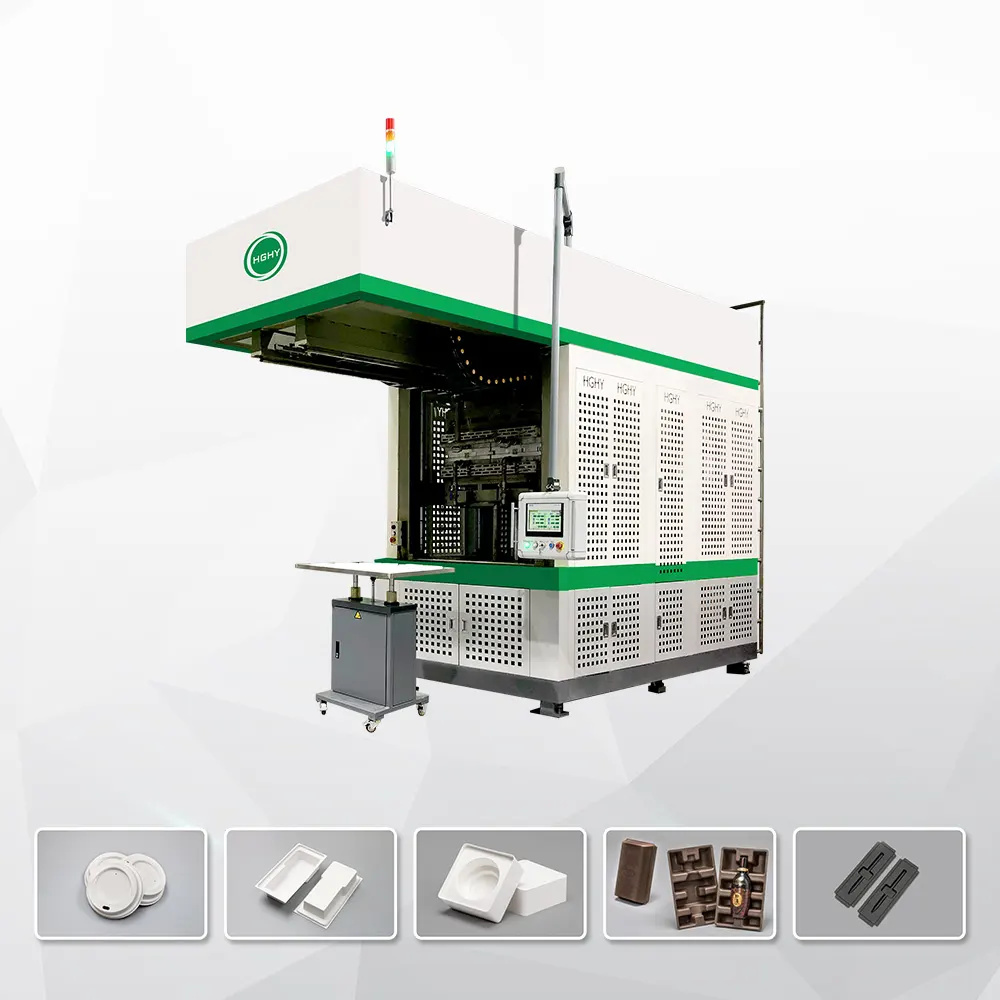In the global pursuit of sustainability, innovative solutions are essential to combat environmental degradation and address the pressing issue of plastic pollution. Among these solutions, the bagasse pulp molding machine stands out as a revolutionary technology that offers a sustainable alternative for manufacturing various products, including tableware, packaging, and more. This article delves into the intricacies of bagasse pulp molding, exploring its process, benefits, applications, and future prospects in detail.
HGHY Bagasse Pulp Molding Machine

Molded Fiber Tableware Production Line
Suitable for the production of plate, fast food box, bowl, cup and other environmental protection paper fiber tableware products.

Pulp Molding High-end Packaging Machine
Suitable for the production of handicrafts, mobile phones, daily necessities, cosmetics, digital products and other exquisite high-grade lining or outer packaging products.
Understanding Bagasse Pulp Molding
Bagasse, the fibrous residue left behind after extracting juice from sugarcane, has long been considered an agricultural waste product. However, advancements in technology have transformed bagasse into a valuable resource for sustainable manufacturing. Bagasse pulp molding involves the conversion of bagasse fibers into molded products through a series of automated processes, offering an eco-friendly alternative to traditional plastic-based materials.
The Functionality of Bagasse Pulp Molding Machine
At the heart of bagasse pulp molding is the specialized machinery designed to transform raw bagasse fibers into molded products. The bagasse pulp molding machine operates through the following key steps:
Pulping: Bagasse fibers are collected from sugarcane processing facilities and undergo a pulping process to break down the fibers into a fine pulp. This pulp serves as the raw material for molding.
Molding: The bagasse pulp molding machine features molds or dies that define the shape and dimensions of the desired products, such as plates, bowls, trays, and packaging. The pulp is evenly distributed into these molds, where it takes on the desired form.
Dewatering: Excess water is removed from the molded pulp products through a dewatering process, which may involve pressing or vacuum extraction. This step is crucial for achieving the desired consistency and strength in the final products.
Drying: The dewatered pulp products are transferred to drying chambers or conveyor systems, where they undergo drying using heat or airflow. This removes residual moisture and solidifies the molded shapes, ensuring structural integrity.
Finishing and Packaging: Once dried, the molded products may undergo finishing touches such as trimming rough edges or applying coatings for enhanced durability and aesthetics. They are then packaged and prepared for distribution.

Advantages of Bagasse Pulp Molding Machine
The adoption of bagasse pulp molding machines offers numerous advantages, making it an attractive option for environmentally conscious manufacturers:
Environmental Sustainability: Bagasse pulp molding utilizes a renewable and biodegradable raw material derived from agricultural waste, reducing reliance on non-renewable resources and mitigating the environmental impact of waste disposal.
Resource Efficiency: The bagasse pulp molding process maximizes resource utilization by repurposing a byproduct of sugarcane production that would otherwise be discarded. This contributes to the circular economy by closing the loop on waste streams.
Versatility and Customization: Bagasse pulp molding machines can be tailored to produce a wide range of products with varying shapes, sizes, and designs to meet diverse consumer needs and market demands.
Biodegradability and Compostability: Products manufactured using bagasse pulp are inherently biodegradable and compostable, offering an eco-friendly alternative to plastic-based materials and reducing the accumulation of non-biodegradable waste in landfills and ecosystems.
Regulatory Compliance: With increasing regulatory scrutiny and consumer awareness surrounding plastic pollution, businesses can demonstrate their commitment to sustainability and meet regulatory requirements by adopting bagasse pulp molding technology.
Applications of Bagasse Pulp Molding
The versatility of bagasse pulp molding extends to various industries and applications, including:
Food Packaging: Disposable plates, bowls, clamshells, and trays for food service applications.
Eco-friendly Tableware: Plates, bowls, cups, and utensils for household and commercial use.
Medical and Healthcare: Biodegradable packaging for medical devices, specimen collection, and single-use products.
Consumer Electronics: Protective packaging for electronic devices and components, reducing reliance on plastic foams and films.
Industrial and Agricultural: Seedling trays, nursery pots, and packaging inserts for agricultural and horticultural products.
Future Outlook and Innovations
As the global demand for sustainable alternatives to plastic continues to rise, the bagasse pulp molding industry is poised for growth and innovation. Key developments and trends shaping the future of bagasse pulp molding technology include:
Advanced Machinery: Ongoing advancements in pulp molding machinery, including automation, efficiency improvements, and customization capabilities, will enhance productivity and expand the range of applications.
Material Innovations: Research and development efforts focused on optimizing bagasse pulp formulations, additives, and processing techniques will lead to improved product performance, durability, and market acceptance.
Circular Economy Initiatives: Collaborative efforts across industries to promote closed-loop systems for waste management and resource recovery will create new opportunities for integrating bagasse pulp products into sustainable supply chains.
Market Expansion: Growing consumer awareness and demand for eco-friendly alternatives will drive market expansion and diversification, with bagasse pulp products gaining traction in global markets across sectors.
Steps to Establish a Molded Pulp Manufacturing Facility
Choose HGHY
HGHY is a leading high-tech enterprise in China, dedicated to the research, development, and production of paper moulding machine. With nearly 30 years of hands-on experience in project operations, our aim is to construct top-tier machinery. Our service network spans over 60 countries and regions globally, with over 1,000 sets of equipment sold and more than 10,000 satisfied customers served.
No Experience Required - Assisting You in Building Your Factory
HGHY provides personalized, complimentary consulting services to clients. We aid in designing and planning your entire factory layout, customize products to meet your specific requirements, and dispatch engineers to your country for equipment installation and troubleshooting. Additionally, we offer training and continuous technical support, all backed by a lifetime service guarantee for HGHY equipment.
OUR CASES
Conclusion
In conclusion, the bagasse pulp molding machine represents a transformative technology with significant implications for sustainable manufacturing and environmental stewardship. By harnessing the inherent properties of bagasse fibers and leveraging advanced machinery and processes, manufacturers can produce a wide range of biodegradable products that offer practical solutions to plastic pollution and support the transition to a circular economy. As the momentum for sustainability continues to build, the bagasse pulp molding industry is poised to play a pivotal role in shaping a greener and more resilient future for generations to come.



